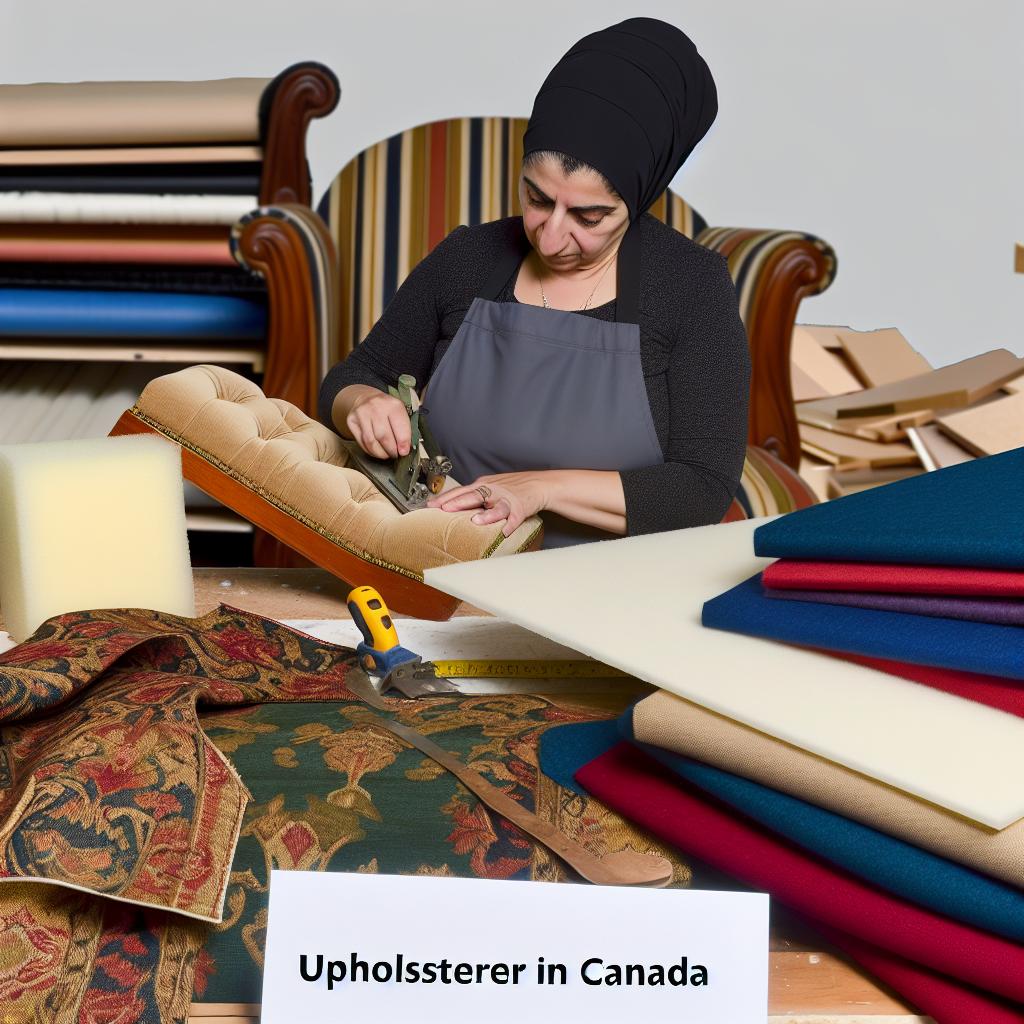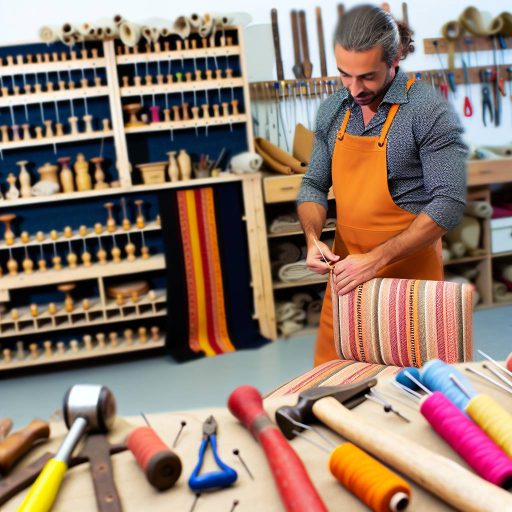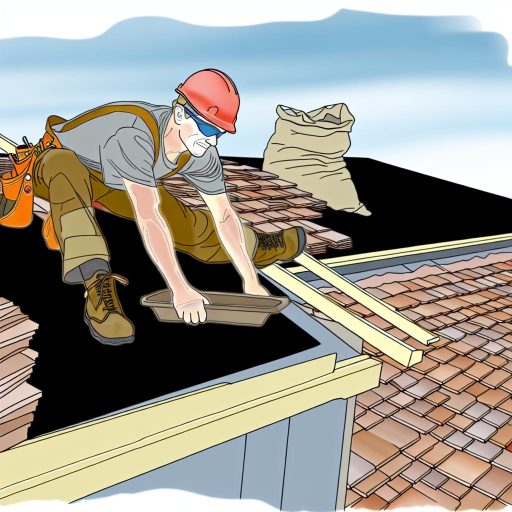Introduction to Upholstery
Definition and Importance
Upholstery refers to the craft of covering furniture with fabric, padding, and springs.
This practice enhances both comfort and aesthetics in home and office settings.
Additionally, upholstery plays a crucial role in preserving furniture quality.
Different materials significantly affect the durability and appearance of upholstered items.
Moreover, upholstery is essential for updating the design of existing furniture.
Skilled upholsterers can transform worn-out pieces into stunning focal points.
Furthermore, upholstery can enhance interior design and reflect personal style.
Many styles, colors, and textures are available for upholstery fabrics.
Choosing the right fabric can influence the overall ambiance of a space.
Overall, upholstery blends artistry and craftsmanship with functionality.
This beautiful craft allows for customization that meets individual needs.
History of Upholstery
Ancient Beginnings
Upholstery dates back to ancient civilizations.
The Egyptians used animal hides and padded textiles.
Also, they crafted elaborate cushions for comfort.
In ancient Greece, furniture was adorned with rich fabrics.
Medieval Developments
The Middle Ages saw functional upholstery for protection.
Thick woolen fabrics lined chairs and benches.
Additionally, padded seats became symbols of wealth.
The Renaissance Era
The Renaissance sparked a revolution in upholstery design.
Craftsmen embraced luxurious materials like silk and velvet.
Intricate embroidery and patterns defined this period.
18th and 19th Centuries
Upholstery evolved significantly during these centuries.
Chesterfield sofas and wingback chairs gained popularity.
Moreover, mechanisms for furniture became more refined.
Manufactured pieces increased accessibility for the masses.
Unlock Your Career Potential
Visualize a clear path to success with our tailored Career Consulting service. Personalized insights in just 1-3 days.
Get StartedModern Upholstery Techniques
The 20th century introduced innovative upholstery methods.
New materials, including foams and synthetic fabrics, emerged.
Design styles diversified to meet changing tastes.
Contemporary Trends
Today, sustainability shapes upholstery choices.
Many artisans focus on eco-friendly materials and practices.
Additionally, vintage and reclaimed fabrics are gaining traction.
Furthermore, technology enhances upholstery design and production.
Materials Used in Upholstery
Fabrics
Fabrics play a vital role in upholstery.
They determine both the aesthetics and durability of furniture.
Common upholstery fabrics include cotton, linen, and polyester.
Natural fibers provide breathability and comfort.
Conversely, synthetic fabrics often offer enhanced durability.
Consider using leather for a luxurious finish.
Moreover, velvet adds a rich texture to any piece.
Choosing the right fabric requires balancing style and function.
Quality fabrics enhance the longevity of upholstered items.
Foams
Foam padding enhances both comfort and support in upholstery.
It comes in various densities and thicknesses.
High-density foam is ideal for seating applications.
This type of foam provides great support and lasts longer.
On the other hand, low-density foam is softer and less durable.
Consider memory foam for its unique comfort properties.
Additionally, natural latex foam is a sustainable choice.
Layering different foams can improve overall comfort.
Springs
Springs contribute significantly to the structure of upholstered furniture.
They provide support and facilitate a comfortable sitting experience.
Different types of springs include coil springs and webbing.
Coil springs offer excellent resilience and reliability.
Webbing provides a flexible base for seating surfaces.
Sinuous springs are popular for their ease of installation.
Properly placed springs improve the overall comfort level.
Regular maintenance of springs ensures longevity in upholstery.
Find Out More: Exploring the Artistry in Bricklaying Designs
Common Upholstery Techniques
Stitching
Stitching is a fundamental upholstery technique that binds fabrics together.
This method ensures durability and a neat finish for upholstered items.
Two primary types of stitching are commonly used: hand stitching and machine stitching.
Hand stitching provides a traditional look, while machine stitching is efficient and fast.
Moreover, choosing the right thread is essential for a successful stitch.
For instance, heavier fabrics require stronger threads to enhance strength.
As a result, selecting the appropriate technique contributes to the overall quality of the piece.
Tacking
Tacking is another vital upholstery technique used for securing fabric.
This method involves using small nails or staples to hold the material in place.
Tacking keeps the fabric taut, which helps avoid wrinkles and sagging.
It is particularly useful in high-stress areas of furniture, such as corners and edges.
Furthermore, tacking provides a neat finish and adds to the overall aesthetic appeal.
In this technique, choosing the right tools enhances efficiency and effectiveness.
For example, a pneumatic stapler can speed up the tacking process significantly.
Padding
Padding serves as an essential component in upholstery, providing comfort and support.
Various materials can be used for padding, including foam, cotton, and down feathers.
Each material offers different levels of firmness and softness.
Additionally, the thickness of the padding affects the overall look and feel of the upholstered item.
Using appropriate padding materials helps achieve a plush and inviting finish.
Moreover, proper installation is crucial for long-lasting comfort.
Gain More Insights: Effective Communication Tips for Bricklayers
Tools of the Trade: Essential Equipment for Upholsterers
Upholstery requires a unique set of tools.
These tools help artisans create beautiful furniture.
They ensure precision and efficiency during the process.
Basic Upholstery Tools
Every upholsterer should have essential tools on hand.
- A staple gun is vital for attaching fabric to frames.
- Scissors are necessary for cutting fabric neatly.
- A curved upholstery needle is perfect for hand stitching.
- Soft mallets help drive in tacks without damaging surfaces.
- A measuring tape ensures accurate fabric cuts.
These tools form the foundation of an upholsterer’s toolkit.
Advanced Equipment
Advanced tools elevate the craftsmanship of upholstery.
- A pneumatic staple gun increases efficiency significantly.
- Electric scissors ease the burden of cutting multiple layers.
- An upholstery sewing machine allows for intricate designs.
- A fabric steamer helps eliminate wrinkles for a smooth finish.
Investing in quality equipment enhances the overall results.
Protective Gear
Safety is crucial when working with upholstery tools.
- Wearing safety goggles protects eyes from flying debris.
- Hearing protection is essential when using loud equipment.
- Gloves can prevent cuts from sharp tools and materials.
Always prioritize safety in the workshop.
Maintaining Your Tools
Proper maintenance prolongs the lifespan of upholstery tools.
Regularly clean and oil tools to keep them in good condition.
Sharpen blades as needed for optimal cutting performance.
Store tools in a dry place to prevent rust and damage.
Taking care of your equipment ensures quality results in every project.
Find Out More: Exploring the Demand for Bricklayers in Canada
Steps to Reupholster a Piece of Furniture: A DIY Guide
Gather Your Materials
Start by collecting all necessary tools and materials.
You will need fabric, foam, staples, and a staple gun.
Don’t forget to have scissors and a measuring tape on hand.
Additionally, you may want a screwdriver to remove old upholstery.
Choose the Right Fabric
Select a fabric that suits your style and durability needs.
Consider the furniture’s purpose when choosing material.
For high-use pieces, opt for durable fabrics like canvas or microfiber.
Color and pattern can also enhance the aesthetic appeal.
Prepare the Furniture
Begin by clearing off the surface of the furniture.
Next, remove any old upholstery carefully.
Use a screwdriver and pliers to take out staples or tacks.
Be cautious to avoid damaging the frame during this process.
Measure and Cut Fabric
Accurately measure each section of the furniture to ensure a proper fit.
Allow extra material for wrapping around edges and seams.
Cut the new fabric according to these measurements.
Attach the New Padding
Place the foam padding on the furniture frame.
Ensure it fits snugly without any gaps or overlaps.
Secure the padding with staples or adhesive spray for stability.
Upholster the Furniture
Start attaching the fabric by positioning it over the padded area.
Begin at the center and work your way to the edges.
Use the staple gun to secure the fabric tightly.
Make sure to pull the fabric taut to avoid wrinkles.
Finish the Edges
Once the fabric is secured, trim any excess material carefully.
Consider adding a decorative trim to enhance the look.
This can give a finished and polished appearance to your work.
Finally, inspect your upholstery for any loose areas.
Clean Up and Enjoy
After completing the reupholstery, tidy up your workspace.
Remove any leftover materials and dispose of them properly.
Admire your work and enjoy your newly reupholstered furniture.
See Related Content: How to Find Bricklaying Apprenticeships in Canada

Design Considerations in Upholstery: Color, Pattern, and Style
Color Selection
Color plays a crucial role in upholstery design.
It influences the mood and ambiance of a space.
When choosing colors, consider the overall interior design.
Neutral colors create a calming environment.
Bold colors can add excitement and energy.
Additionally, be mindful of how light affects color perception.
Lighting can change how colors appear at different times of day.
Patterns and Textures
Patterns add character to upholstered pieces.
They can range from subtle to bold, depending on your preference.
Stripes can create a sense of height or width.
Floral patterns often evoke a warm, inviting atmosphere.
Textures also play an important role in upholstery design.
Soft fabrics like velvet provide a luxurious feel.
Moreover, durable fabrics like canvas are practical for high-traffic areas.
Style Consistency
Upholstery should reflect the overall style of the space.
Modern designs often feature clean lines and minimalistic forms.
Traditional styles may include ornate details and rich textures.
Transitional styles blend both modern and traditional elements.
Whichever style you choose, ensure it complements existing decor.
Consistency in style helps create a cohesive look throughout the room.
Functional Considerations
Functionality should guide your upholstery decisions.
Choose fabrics that suit the intended use of the item.
For example, consider durability for furniture in busy areas.
Water-resistant fabrics are ideal for outdoor upholstery.
Similarly, think about how easy it is to clean and maintain materials.
Practical choices prolong the life of your upholstered items.
The Role of Upholstery in Interior Design
Enhancing Aesthetics
Upholstery plays a crucial role in interior design.
It significantly enhances the visual appeal of a space.
This craft involves covering furniture with fabric, padding, and springs.
Additionally, upholstery adds touch and comfort to various pieces.
Different fabrics and patterns can set the mood of a room.
For example, vibrant colors can energize a space.
In contrast, neutral tones create a calm atmosphere.
Moreover, textures also contribute to the overall design theme.
Soft fabrics invite relaxation, while sleek materials suggest elegance.
Functional Benefits
Upholstery serves a dual purpose: style and functionality.
It protects furniture from wear and tear over time.
Well-chosen upholstery extends the lifespan of pieces.
Furthermore, upholstery can enhance comfort levels in furniture.
High-quality padding provides better support and seating experience.
Indeed, comfort plays a major role in how spaces are used.
Personalization and Style
Upholstery allows for immense personal expression.
Homeowners can choose fabrics that reflect their personalities.
Tailored upholstery services can create unique pieces for clients.
These customizable options enhance the overall design aesthetic.
In addition, upholstery can adapt to different trends and styles.
From vintage to modern, the choices are virtually limitless.
Upholstery in Sustainable Design
Many designers now consider sustainability in upholstery choices.
Recycled materials offer environmentally friendly options.
Natural fibers such as cotton and wool reduce ecological impact.
Moreover, long-lasting upholstery materials minimize waste.
Sustainable upholstery links aesthetics with responsible living.
Sustainability in Upholstery
Eco-Friendly Materials
Upholstery today embraces eco-friendly materials for a sustainable future.
Natural fibers like organic cotton and hemp are great choices.
These materials have minimal environmental impact compared to synthetic options.
Moreover, recycled fabrics offer another sustainable avenue.
Designers increasingly use reclaimed textiles to reduce waste.
Additionally, traditional materials like leather can be sourced ethically.
This ensures they come from sustainable farms or recycled sources.
Responsible Practices
Sustainability involves not only materials but also practices.
Skilled upholsterers prioritize local sourcing to minimize transportation emissions.
They also follow waste reduction methods during production.
This includes recycling scrap materials and reusing components.
Engaging in sustainable manufacturing practices enhances overall industry standards.
Furthermore, it creates a market for environmentally conscious consumers.
These practices promote better relationships with nature and the community.
Consumer Involvement
Consumers play a crucial role in promoting sustainability.
Choosing eco-friendly upholstery encourages manufacturers to adapt environmentally responsible practices.
Supporting brands committed to sustainability helps drive industry change.
Moreover, consumers can advocate for transparency in sourcing and production methods.
This encourages brands to share their sustainability stories more openly.
By making informed choices, consumers directly influence market trends.
Collectively, these preferences shape a more sustainable future for upholstery.
Additional Resources
Francis Tuttle Technology Center | We Prepare You for Success
What are some trades/crafts I could master so that I’d have a part …




